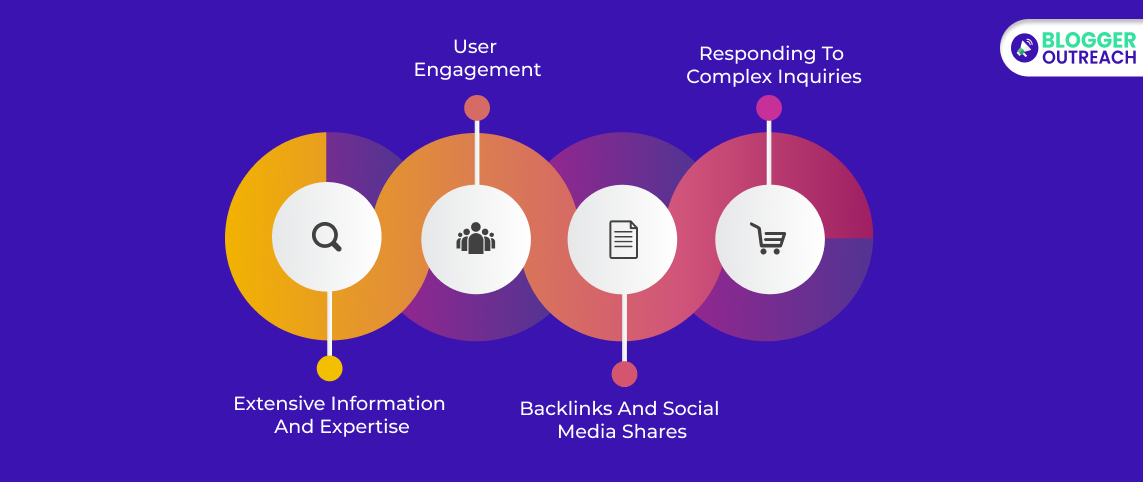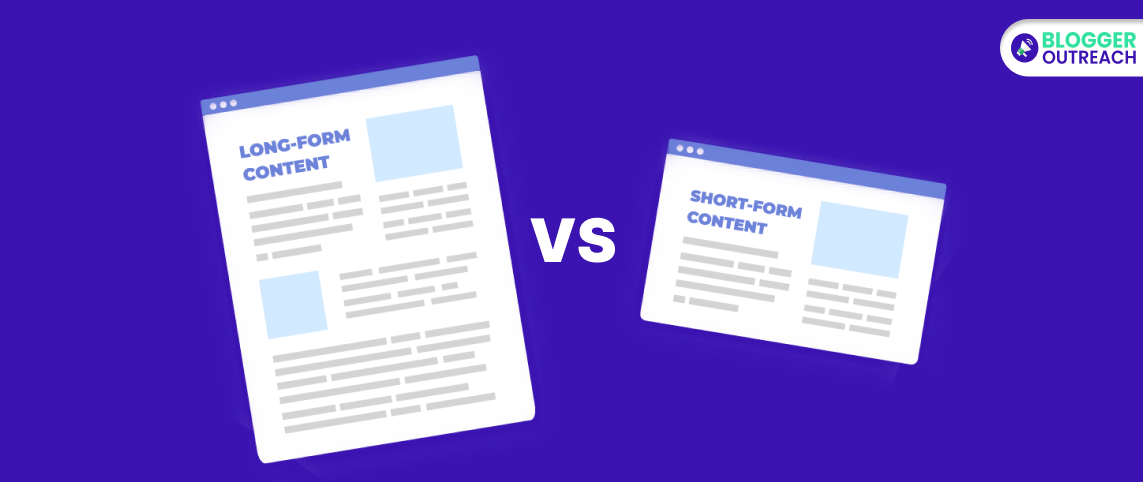As digital marketing enthusiasts, all of us are definitely aware of the unparalleled importance of creating a well-designed content marketing strategy. And, of course, the exponential growth it can deliver if you get everything right!
However, like any other segment of advertising, content marketing, too, carries a host of rumors and misconceptions that cloud our judgment. And, the following is one of them –
“The longer your written blog is, the better it will perform in terms of SEO!”
Frankly speaking, that’s not entirely true!
Long-form content isn’t essentially better than short-form ones. As with several other aspects of SEO, it will depend on the tone and intent of your write-up.
So, how are you going to understand if writing a long-form article for your blog section will be overkill or not?
Don’t worry, we’ve got your back!
In this guide, we will tell you a few ways to determine how much you should write depending on the topic at hand.
But, Before We Dive Deeper Into The Rabbit Hole, Let Us Enlist What You’re Going To Learn –
- What is long-form content?
- The definition and formats of short-form content.
- Is the length of your write-up important?
- A guide to deciding the length of your content.
So, let’s begin venturing through the pressing matters right away!
Table Of Content
Long-Form Vs Short-Form – A Never Ending Debate
Before you can determine the content length, you will need to have a clear idea regarding the definition of short-form and long-form content. Here are some details that can help you with it.
What Is Long-Form Content?
A long-form blog typically constitutes around or more than 1000 words. When you are writing such content, you have to delve deeper into the topic and cover every possible information through it.
The Formats Of Long Form Content Will Include –
- Evergreen blogs.
- Lengthy and details articles.
- Tutorials and guides.
- e-Books and whitepapers.
- Virtual events and webinars.
- Pillar pages.
A long-form blog isn’t your regular quick-to-consume content due to the amount of information it offers. It specifically aims to inform or educate the audience and helps them find answers to a specific question that’s troubling them. If written while keeping the user intent in mind, long-form writing can create the backbone of a unique SEO strategy.
What Is Short-Form Content?
Contrary to the previous option, a short-form blog will carry somewhere between 500-1000 words in length. Hence, in this aspect, you have to select a topic that’s short, crisp, and easy to digest. Some of the common short-form content formats may include –
- News articles.
- Short articles.
- Social media content.
- News articles.
- Emails.
The goal of a short-form post should be to send the message you want to convey to your audience directly. In our opinion, it’s best to share one idea through content and keep it as simplistic as possible. Just make sure to keep the tone as engaging as possible.
Why Long Form Content Works Best In Some Situations?

Long-form content can perform well in some situations, especially where comprehensiveness and depth are required. Let’s investigate this more thoroughly:
(i) Extensive Information And Expertise
Unlike short-form content, long-form content lets you go deeply into a subject, exhibiting your knowledge and offering in-depth views.
Both readers and search engines will greatly respect your authority in your subject, which may be established by providing this depth of knowledge.
(ii) User Engagement
Well-written long-form content may hold readers’ attention for extended amounts of time. Search engines interpret this longer time on the page as evidence that your content is worthwhile and pertinent to readers.
In-depth articles have a higher chance of receiving links from other websites and being shared on social media.
Your content’s chances of ranking highly in search engine results increase with the number of backlinks and shares it acquires.
(iv) Responding To Complex Inquiries
Long-form content is crucial for search inquiries that call for in-depth responses.
Detailed articles are more likely to match search engines‘ criteria of providing users with the most full and relevant information.
Should The Length Of Your Content Matter?
Yes, the length of your content matters much more than you can imagine, both from the SEO and user-related viewpoint. However, it doesn’t mean that you should think that longer content is better than shorter ones.
So, what’s our point?
Well, in our opinion, your content length should depend on the objectives you’ve set and the purpose you want to serve through it.
And, For That, You Have To Focus On Two Aspects –
- The search intent of the user.
- Choosing the right format for the content.
However, there’s an exception.
According to a research module, long-form content performs significantly well when it comes to getting backlinks for your website. And, the same goes for the organic searches as well!
Why?
It’s because a few search queries require a blog to cover the subject in great depth. And, if you don’t do that, you won’t be able to fulfill the “following user intent” requirement of the search engines. So, in case another website offers more information on the same topic, their chance of ranking higher will increase even more.
Balancing Long And Short-Form Content
An effective SEO strategy frequently revolves around striking a balance between lengthy and short form content.
Here’s How To Include Both In Your Strategy For Content Marketing:
1. Identify Your Audience
With analytics software, examine the preferences and actions of your target audience. Ascertain which kind of content appeals to your viewers the most. If in-depth analyses are more engaging for your audience, concentrate on creating lengthy form content.
On the other hand, give short form content priority if they like to read quickly. Customizing the length of the content to the tastes of your audience guarantees increased satisfaction and engagement.
2. Topic Relevance
Determine whether subjects are more appropriate for short or long-form content. Extensive manuals, like a thorough SEO plan, are perfect for lengthy publications.
For brief postings, quick updates—like the most recent algorithm change—are preferable. Delivery of value and efficient communication are ensured when content length and topic complexity are in line.
3. Content Objectives
Match the length of your content to your particular objectives. To establish authority, increase organic traffic, and create backlinks, use lengthy form content.
Short form content is helpful for giving short updates, keeping up a regular publishing schedule, and interacting with followers on social media. Different content strategies are required for different aims.
4. Lifecycle Of Content
Over the course of your content lifecycle, incorporate both kinds of content. To draw visitors to your website and grab their attention, start with short form content.
Then, direct these visitors to long-form content to increase conversion and deeper interaction. Throughout the buyer’s journey, this strategy cultivates the audience.
5. Combination Method
A mixed strategy may work well. Start with a little article to determine reader interest and generate some first interaction.
Expand the information into a long form piece with more detail and value based on the reaction. With this approach, you can confirm that a topic is relevant before making a significant investment in long-form content.
Hence, you can optimize your SEO potential and accommodate a range of reader preferences by knowing your audience, coordinating content with objectives, and deftly combining the two forms of content.
How To Decide The Length Of Your Content?
In reality, both short-form and long form content have their own importance, in terms of SEO and serving specific user intent. Therefore, we would ask you to balance between them to meet the requirements of your audience.
In this guide, we will tell you how you can determine the length of your content by considering three factors. Here’s what you need to know about them.
Consideration – 1: What Does Your Audience Want?
Before you begin writing exclusively on a topic, you’ll need to know what your audience wants from you.
For example, if you are writing about a guide, you have to explain the pain points of your readers first. Once you’re done, you can, then, move on to solving their problems. So, in that case, it would naturally become long form content for you.
Here Are Some Questions That You Should Ask Yourself To Understand What Your Audience Wants Better:
- What type of content has the highest conversion rate in your niche?
- Which form of the article has the best session duration and lowest bounce rate?
- What kind of posts is driving more engagement on social media?
The more insights you can get from your audience, the more prepared you will be while curating the next steps of your strategies.
Consideration – 2: What Is Your Aim?
If you aren’t aware of the path you are taking, how would you what’s out there waiting for you at the end? Right?
That’s precisely why we always ask everyone to determine their goal of content marketing before taking another step into the universe.
However, the aspect of setting an aim shouldn’t only depend on your overall content strategy. You have to imply it on every blog you curate. Otherwise, it will be impossible for you to serve your user intent properly and offer proper guidance to your audience.
Let’s take an example or two to understand our point better.
If you’re aiming to raise awareness of a brand new product launch, sending a concise and to-the-point mail should be an effective strategy. So, creating short-form content should be your go-to option in this respect.
Conversely, if you want to rank higher on Google on a competitive search term, you must write a long-form blog.
Consideration – 3: What Should Your Conversion Path Be?
So, have you found out what your goal and audience’s search intent is?
Great!
Now, let’s move on to the next and final consideration – your conversion path.
How many touchpoints do you think a potential customer makes before converting into a regular consumer? Yes, you’ll need to consider this point as well when it comes to deciding between writing short-form and long form content.
For instance, the conversion window for an eCommerce retailer is pretty short, particularly due to the low order value. Hence, they can release short-form posts on social media to drive sales and boost their conversion rate massively.
However, the same strategy will not be applicable to a B2B software platform. They have to pave their conversion path by nurturing their audience through informative and educational content. And, the publishing must be done over time, instead of uploading everything at once.
Frequently Asked Questions (FAQs):
A: A short-form post tends to carry around 500-1,000 words. The purpose of the content is to be crisp and to the point. On the other hand, a long-form blog will be much more insightful and consist of more than 1,200 words.
A: Some of the common examples of long form content are –
1. Definitive guides.
2. Case studies.
3. White papers.
4. eBooks.
5. Reviews and roundups.
6. Datasheets and brochures.
A: Here are some tips that can help you write long-form articles for your website’s blog section –
1. Keep user intent in mind.
2. Write in a simple yet informative tone.
3. Choose a high-volume focus keyword and use it evenly throughout the content.
4. Avoid writing longer sentences.
5. The word count should be higher than 1,500 words.
Finalizing It Up!
Let’s be honest – writing SEO-optimized, high-quality content can be extremely challenging for anyone. And, if you already have your plates full (which is quite obvious for a marketer), jotting down your expertise on a topic will be impossible.
So, are you still considering tackling your plan all alone? Or, do you need a hand?
If so, you can reach us at BloggerOutreach today. We are a full-fledged content writing agency that utilizes a content-first approach to engage consumers, educate audiences, and drive excellent link acquisition.
Due to our experience and expertise, we’ll establish the right branding voice through your blogs and ensure that it ranks on the SERPs. Aside from writing regular articles, we can also help you with curating newsletters, guides, case studies, whitepapers, web page content, etc.
Therefore, contact us today to get started with your content writing and marketing journey as soon as possible!
Read Also:









